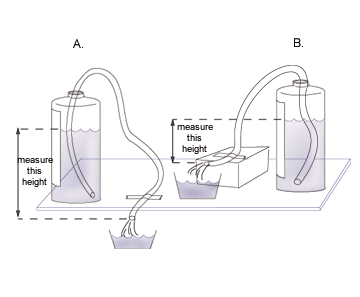 For each system A and B, plot your data in a line graph that shows how the water
level depends on time.
For each system A and B, plot your data in a line graph that shows how the water
level depends on time.If we wanted to get the water out of a bath tub whose drain was not working, we would need a rapid siphon; a slow siphon might be useful to keep your pet salamander wet while you cleaned out her cage. So we need to determine what affects the flow rate, so we can do these things. Here are some factors that might be involved:
You could design an interesting experiment to study any of these, and each would give insight into the behavior of electrical systems, when we develop that analogy. However, let's choose to study the effect of the height of the outlet end of the tube.
The height that you should measure is shown in the diagrams below. It is the difference between the level of water in the bottle, and the height of the end of the tube where the water flows out (use a large container to catch the water that flows from the tube. Tape the end of the tube securely in place while the water is flowing).

As water flows through the system in each of the diagrams A and B, collect a set of data for the level of the water in the container every 30 seconds.
For each system A and B, plot your data in a line graph that shows how the water level depends on time.
 For each system A and B, plot your data in a line graph that shows how the water
level depends on time.
For each system A and B, plot your data in a line graph that shows how the water
level depends on time.
What could you do to make the flow rate really fast or really slow?
Check the box when you are
done:
Next:Science content: energy, fluids, and siphons